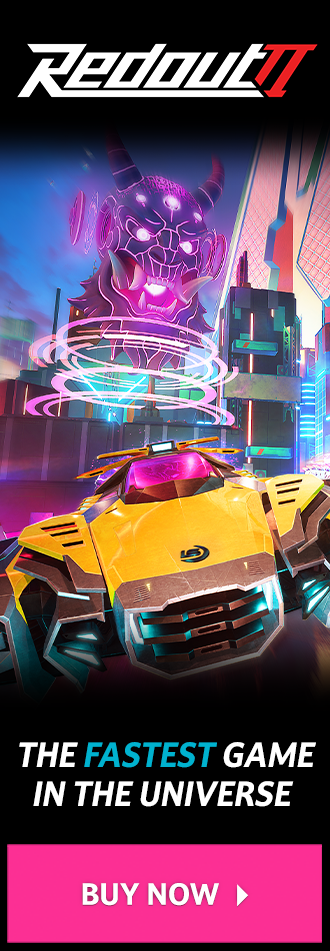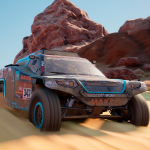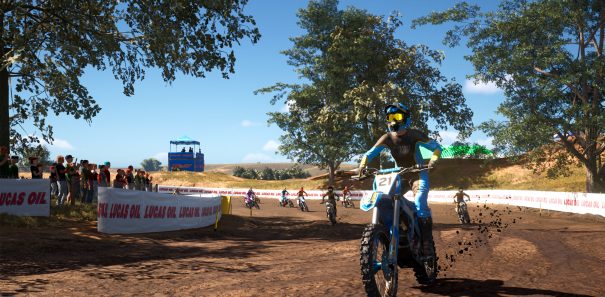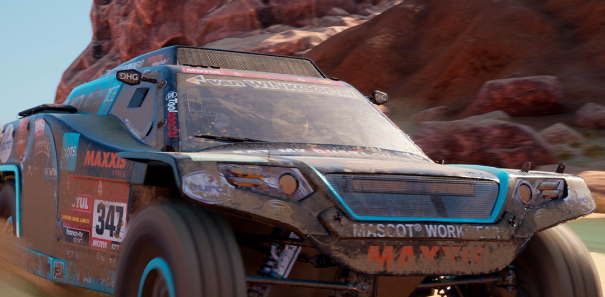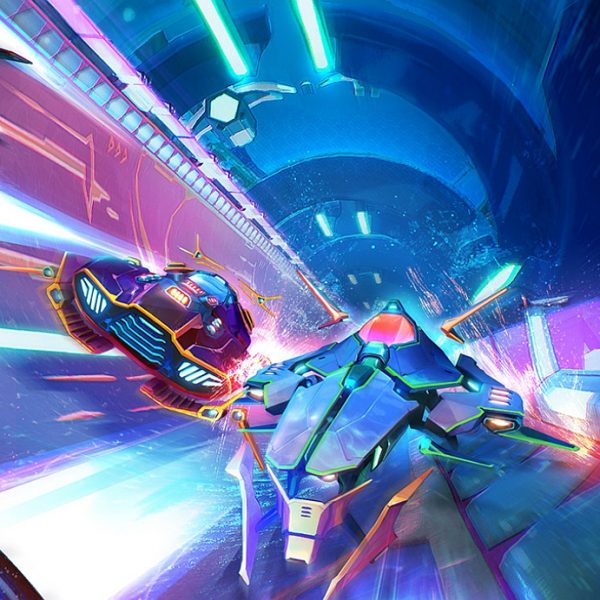When I first started playing racing games back in the '90s, I didn’t care about racing – I cared about crashing. Instead of racing against opponents, I would deliberately drive the wrong way and cause as much carnage as possible. Yes, I was a slightly sadistic child. So imagine my delight when I discovered someone turned this idea into a game with Carmageddon, a game that rewarded you for ignoring the route of the race and purposely smashing into opponents.
Nearly 20 years after the release of the original, the Carmageddon series is making a comeback on consoles with the release of Carmageddon Max Damage, which retains the series’ violent vehicular combat and surreal sense of humour. With so many serious simulations flooding the market lately, Carmageddon Max Damage is exactly what the racing game genre needs right now.
With original developer Stainless Games back behind the wheel, we spoke with the studio’s Co-Founder and Brand Director Neil “Nobby” Barnden to find out more about the series’ lasting legacy and what you can expect from Stainless Games' latest pedestrian slaughter fest.
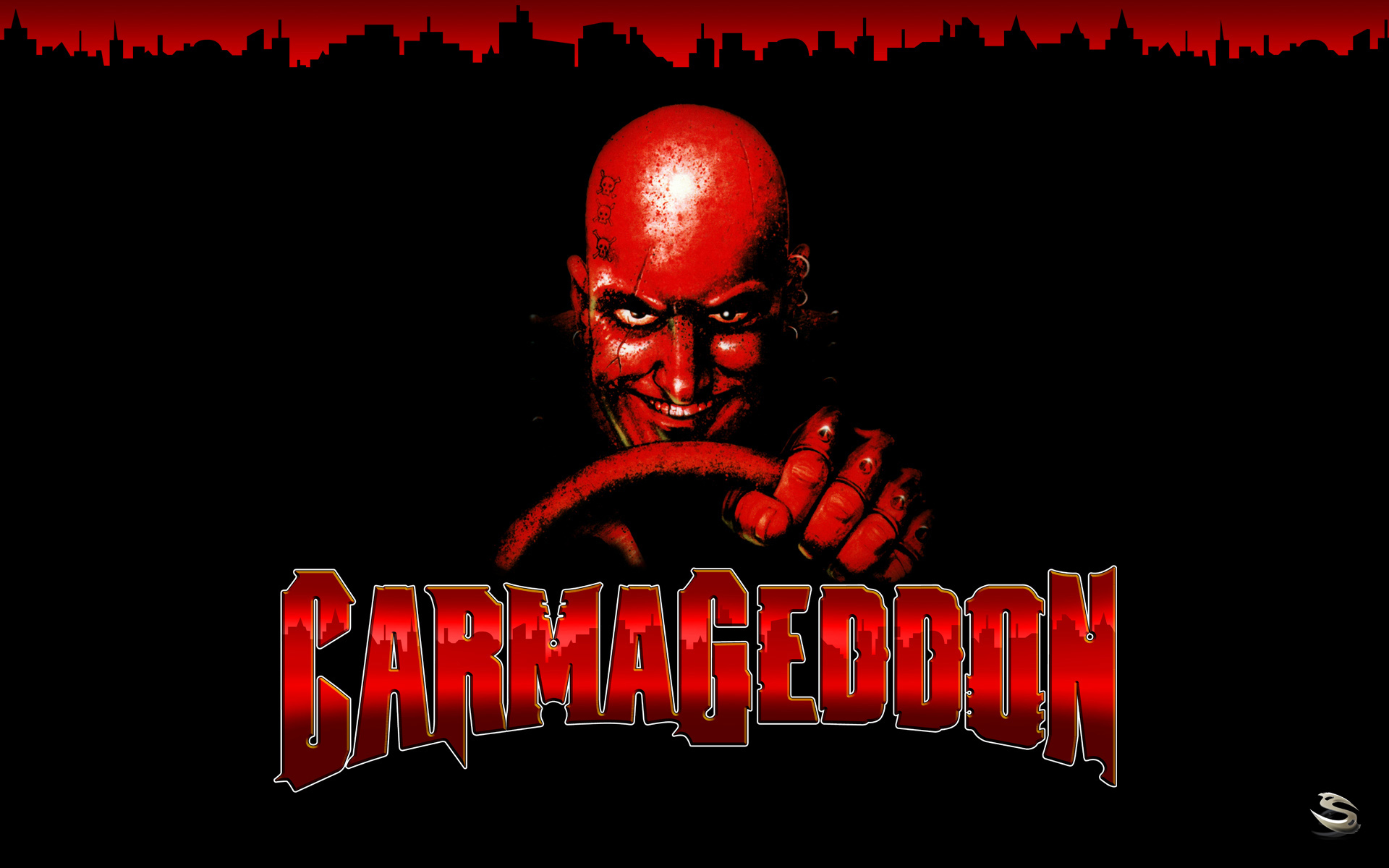
“I accidentally wandered into the games industry way back 20-something years ago, when in the early 1990's I rashly agreed to join forces with Patrick Buckland (Stainless Co-Founder and Chairman) to do the art for a game he was coding,” Barnden recalls. “At that time Patrick was coding on the Mac, and I was a graphic designer and illustrator also using the newly emerging tool for graphic artists; the Apple Mac. The first game we worked on together was a Mac game, Crystal Crazy, the follow-up to Patrick’s big hit Mac game Crystal Quest.”
“Patrick was a long-time banger racer and roped me into doing a bit of that too, and he had a grand ambition to make a Banger Racing (Destruction Derby) game, in full 3D with realistic physics and real-time damage,” says Barnden. ”So, we put together a small demo game with a simple oval track, three cars and a prototype ‘PratCam’ (a PIP image showing the driver’s comedy reactions to the action), and hawked our demo video around publishers.”
“This led to interest from small English publisher SCi, who were pursuing the rights to the license for a game based on the cult ‘70s movie Death Race 2000. They saw our tech (and our humour/mentality!) being a good fit for that game. And so, contract drawn up, Stainless Games (originally Stainless Software) was born – a team of 8 fresh-faced young enthusiastic nutters with little idea of what lay ahead.”
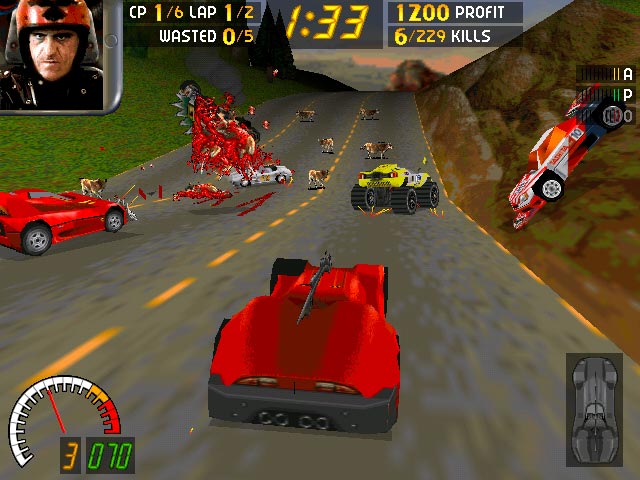 To increase the potential sales for the small publisher, SCi wanted to release a game tied to a film license. “SCi were trying to license Death Race 2000 (well, more specifically a comic series spin-off from the movie, called Death Race 2020),” says Barnden. “Our early development work reflected this assumption – in fact the exe name remained ‘Deathrace.exe” for the duration of development. The license never got secured, but the influence of the movie/comic was retained as the theme for the game – all we needed was to give it a name. I came up with Carmageddon, and the brand was born!”
To increase the potential sales for the small publisher, SCi wanted to release a game tied to a film license. “SCi were trying to license Death Race 2000 (well, more specifically a comic series spin-off from the movie, called Death Race 2020),” says Barnden. “Our early development work reflected this assumption – in fact the exe name remained ‘Deathrace.exe” for the duration of development. The license never got secured, but the influence of the movie/comic was retained as the theme for the game – all we needed was to give it a name. I came up with Carmageddon, and the brand was born!”
Back in the late ‘90s, car combat games were flooding the market with popular titles such as Destruction Derby, Twisted Metal and Vigilante 8. What set Carmageddon apart, however, was that it let you mercilessly mow down pedestrians for points. It looks tame for today's standards, but, despite Carmageddon’s comedic, tongue-in-cheek tone, impaling innocent bystanders with spike-mounted cars in a 3D videogame was genuinely shocking at the time. Along with Grand Theft Auto released the same year, Carmageddon represented the rise of violent video games as the industry reached a turning point.
Unsurprisingly, Carmageddon attracted copious controversy in the media which gave the game some much needed exposure for SCi. ”The saying ‘no publicity is bad publicity’ may be true up to a point, but the fact the game got banned and refused release in some territories also led to headaches as we had to make adjustments to the artwork and game code to get the game accepted for release,” says Barnden.
“Of course, the controversy generated by all this led to the game receiving considerable publicity and exposure in the media, and Carmageddon became somewhat notorious. But gamers loved the title, and – no doubt somewhat boosted by its reputation as a ‘Bad Boy’ of the game world – it went straight into the video game charts at No.1, and went on to sell over 100 million copies worldwide.”
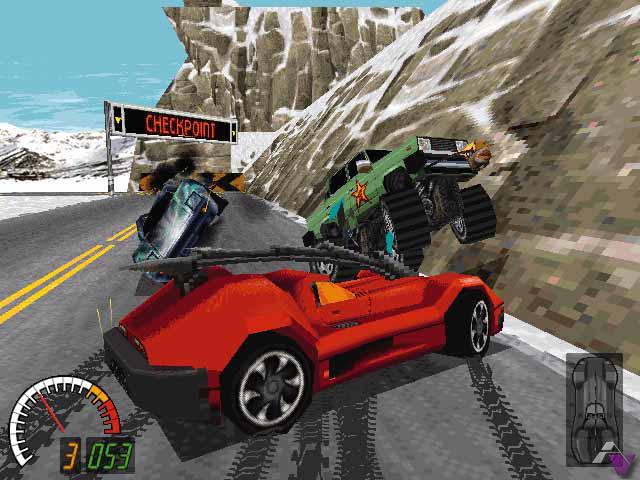 However, SCi's decision to submit Carmageddon for classification backfired spectacularly since it wasn't a requirement. As a result, Carmageddon had to be censored in some territories before it could be granted release, and was even banned from sale in some countries. “The game was refused an 18 certificate by the British Board of Film Certification, blocking release in the UK until the game’s ‘innocent victims’ were replaced by zombies. In Germany, the pedestrians had to become non-humanoid floating tin-can robot things (the German USK rating board refused to rate the game, a status the game still has in Germany today!). And Carmageddon was banned outright in Brazil and Australia.”
However, SCi's decision to submit Carmageddon for classification backfired spectacularly since it wasn't a requirement. As a result, Carmageddon had to be censored in some territories before it could be granted release, and was even banned from sale in some countries. “The game was refused an 18 certificate by the British Board of Film Certification, blocking release in the UK until the game’s ‘innocent victims’ were replaced by zombies. In Germany, the pedestrians had to become non-humanoid floating tin-can robot things (the German USK rating board refused to rate the game, a status the game still has in Germany today!). And Carmageddon was banned outright in Brazil and Australia.”
“In the UK the BBFC’s original decision was overturned in the High Court, allowing SCi to get a second round of publicity and relaunch the game in its original form. So eventually the controversy and censorship worked in the game’s favour!” ‘Blood patches’ were then released to allow players to restore the game’s original look.
However, Barnden doesn’t believe Carmageddon Max Damage will generate the same level of controversy. “20 years later, the world has moved on, and the bounds of what’s acceptable in videogames has changed,” says Barnden. “This means that Carmageddon: Max Damage can be enjoyed for what Stainless Games always intended it to be – an action-packed combat racing title, and a slapstick celebration of cartoon violence.”
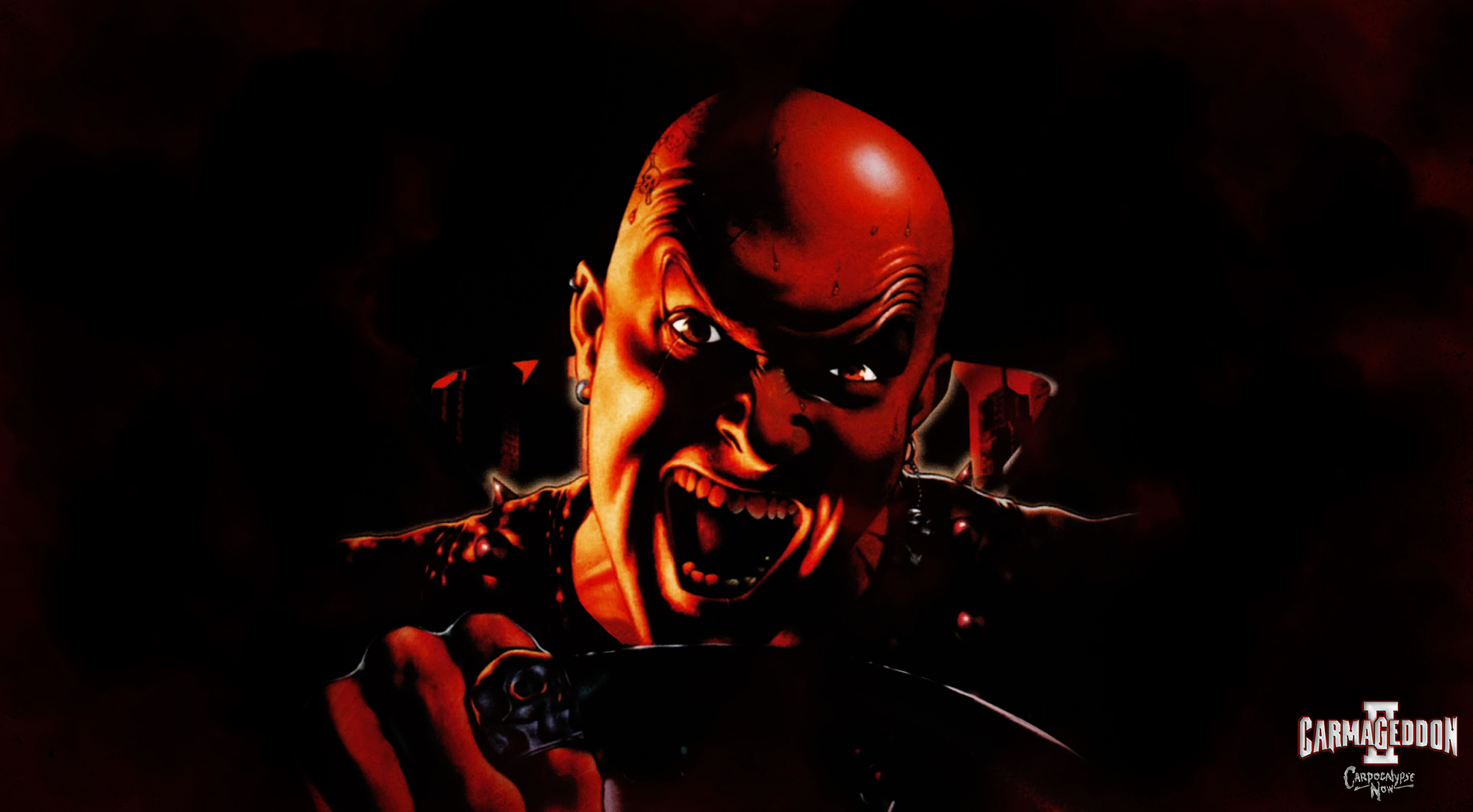
The success of Carmageddon on PC led to a sequel released a year later in 1998. Carmageddon II: Carpocalypse Now brought improvements to the visuals, more advanced damage modelling and fully 3D pedestrians to kill for the first time. “We spent 15 months developing Carmageddon, went from that straight to the mammoth ‘expansion pack.’ The Splat Pack (effectively another Carmageddon game), and then from that straight into Carmageddon II – which was developed in 18 months. So we really didn’t have time to do much more with the design than commit to 3D pedestrians and the introduction of player-triggerable PowerUps."
While Carmageddon was ported to PlayStation, N64 and even the Gameboy Colour, Carmageddon II remained a PC exclusive due to the hardware limitations of other formats, although content from the sequel was used in the ports. “As the first Carmageddon hadn’t even made it onto console by then, there was little hope that Carmageddon II would get ported,” says Barnden. “We were really pushing the power of pretty good PCs back then (we’ll never learn!), and the gap between the capabilities of PC and console was quite a gulf. With our real-time damage, physics and poly-heavy scenes, there was no real chance a PlayStation or Xbox could cope.”
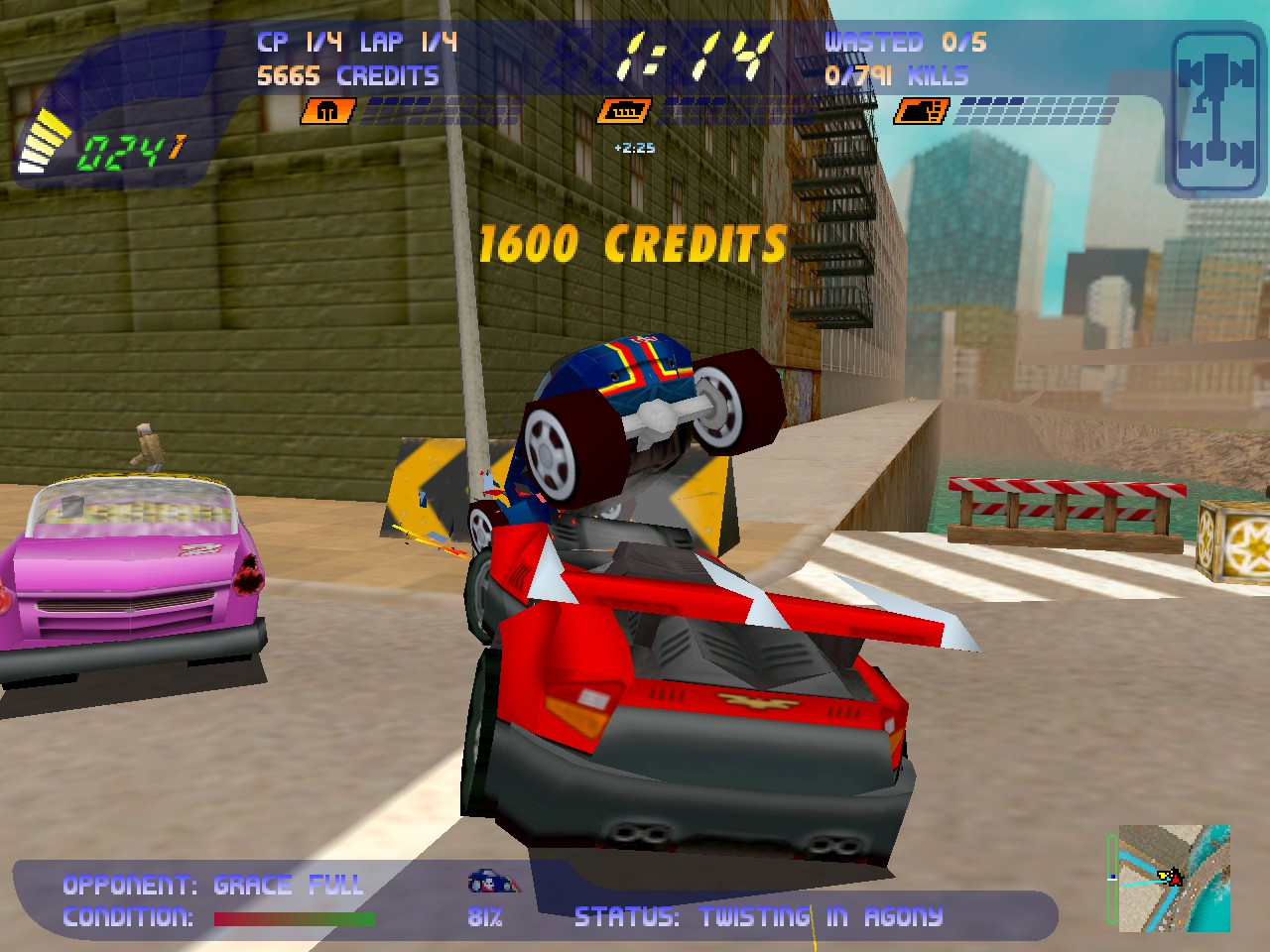 A third Carmageddon game followed, but Stainless Games were not involved with the project. Released in 2000, Carmageddon TDR 2000 was developed by Torus Games, but it failed to replicate the charm of the original.
A third Carmageddon game followed, but Stainless Games were not involved with the project. Released in 2000, Carmageddon TDR 2000 was developed by Torus Games, but it failed to replicate the charm of the original.
“With no consultation between ourselves and Torus on their version of a Carmageddon game, I’d say the difference between the Stainless vision of Carmageddon and the way TDR 2000 turned out was pretty vast. I thought it was a pretty ugly looking game with frustrating gameplay, and still do,” Barnden admits. “But it does have its fans among the Carmageddon community. And if I’m honest, although I find Carmageddon II fun to play, these days I’m not really a big fan of how it looks either.”
SCi continued publishing the Carmageddon series after Carmageddon II, but Stainless subsequently lost the rights to the license. “When we signed with SCi, they owned the rights to the work we did. That was commonly how the publishing industry worked then, and largely still does – the entity putting up the money is taking the risk, after all,” Barnden explains. “TDR pretty much killed off the brand, and although there were attempts by SCi to revive it (Patrick and I even did some consultancy work on potential projects for them), nothing came to fruition. SCi then acquired Eidos. And then Square Enix bought SCi/Eidos.”
With the license in limbo, a new Carmageddon game seemed unlikely, but Barnden was keen to revive the brand. “We’d speculated about getting the chance to do another Carmageddon game someday. But when Square ended up with the rights to the brand, we agreed it was unlikely they’d ever make any use of it,” says Barnden. “However, that being the case, we thought why not see if they would sell the rights to us? We had a friend at Square in a senior position with whom we were able to get the discussion started. And after what turned out to be a few years of negotiations, we finally got our baby back!”
Having reclaimed the license, Stainless sought to reintroduce Carmageddon to new and old audiences alike starting with re-releases of the original game. “Reincarnating the brand began with a port of the original Carmageddon to mobile devices, which turned into a bigger project than originally intended, took longer than intended and cost a lot more than intended! But the result was a great success, with the game being better than the original and working great on mobile devices.”
https://youtube.com/watch?v=yfvR8-quyP0%3Frel%3D0
What fans wanted to see however was a new Carmageddon game running on current tech. In 2012, Stainless answered player’s prayers with the announcement of Carmageddon Reincarnation on Kickstarter.
“Carmageddon: Reincarnation began as a small shoestring budget affair, the intention being for it to be a modest title that reintroduced some of the content of the original game updated for a modern audience,” Barnden explains . “Then, not long after we started work on it, Double Fine Adventure exploded with success on Kickstarter. We all agreed we should go after some of this newfound crowdfunding goodness too, and our Kickstarter campaign swiftly followed! It was a success, the project asked for $400k and got over $650k, and it added to the whole ‘story’ of bringing back the brand to those fans who like us wanted to see the game return.”
With funding secured, Carmageddon Reincarnation was released to the public on Steam Early Access in 2013. Unfortunately, however, the team was overambitious with their resources. Aptly, the release was something of a car crash. Severe performance issues meant that Carmageddon Reincarnation was virtually unplayable for the majority of players – even if their PCs should have been more than capable of running the game.
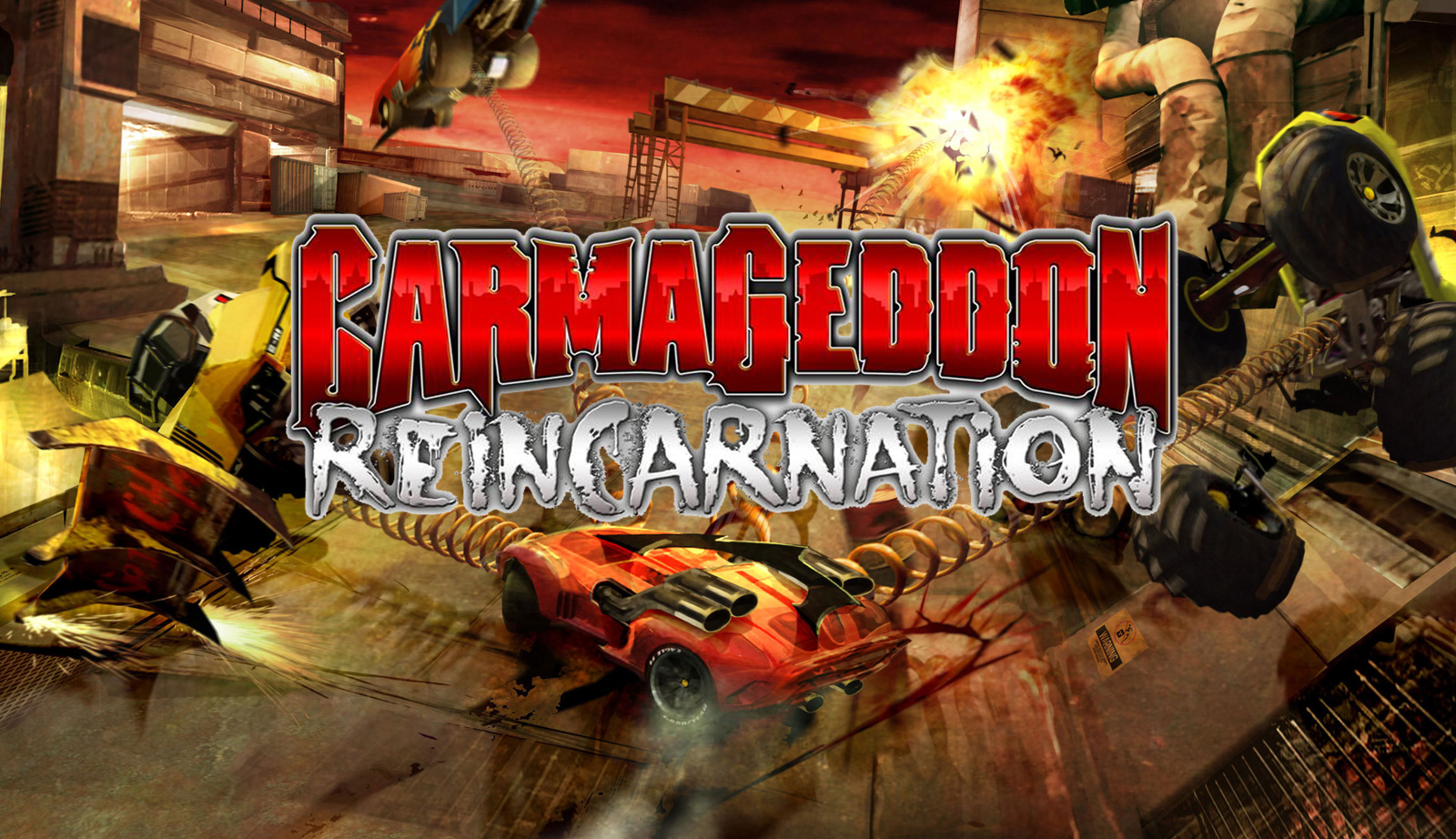
“Carmageddon: Reincarnation turned into a bigger project than originally intended, took longer than intended and cost a lot more than intended!” says Barnden. "The result was far more content and far more game than we originally intended. Which sort of hints at a pattern in game development – particularly when the project is one dear to your heart.”
“However, along the way we had failed to address some fundamental issues – both with our own tech’s capabilities, and also with the expectations of a modern gaming audience,“ Barnden admits.
“When the project began we assessed the middleware available – Unreal Engine, CryEngine, Unity, etc – and concluded it was going to be either too expensive or too technically limited for what we wanted to do. And hey, we still had our own tech that had been under constant development since the original game, so if we could, we should use that!” says Barnden. “However, no-one realised how far behind our tech had slipped – particularly on the rendering/shaders side of things. And with a small budget and very small team, it proved to be a mammoth struggle, and the render tech ended up being rewritten three, maybe four times through the course of the project.”
“After all that, we still ended up with a sub-par renderer struggling to cope with how complex our scenes were. And on top of that all the other technical heavyweights in the game, the real-time crushing code, Action Replay etc. put even more strain on even a high spec PC!”
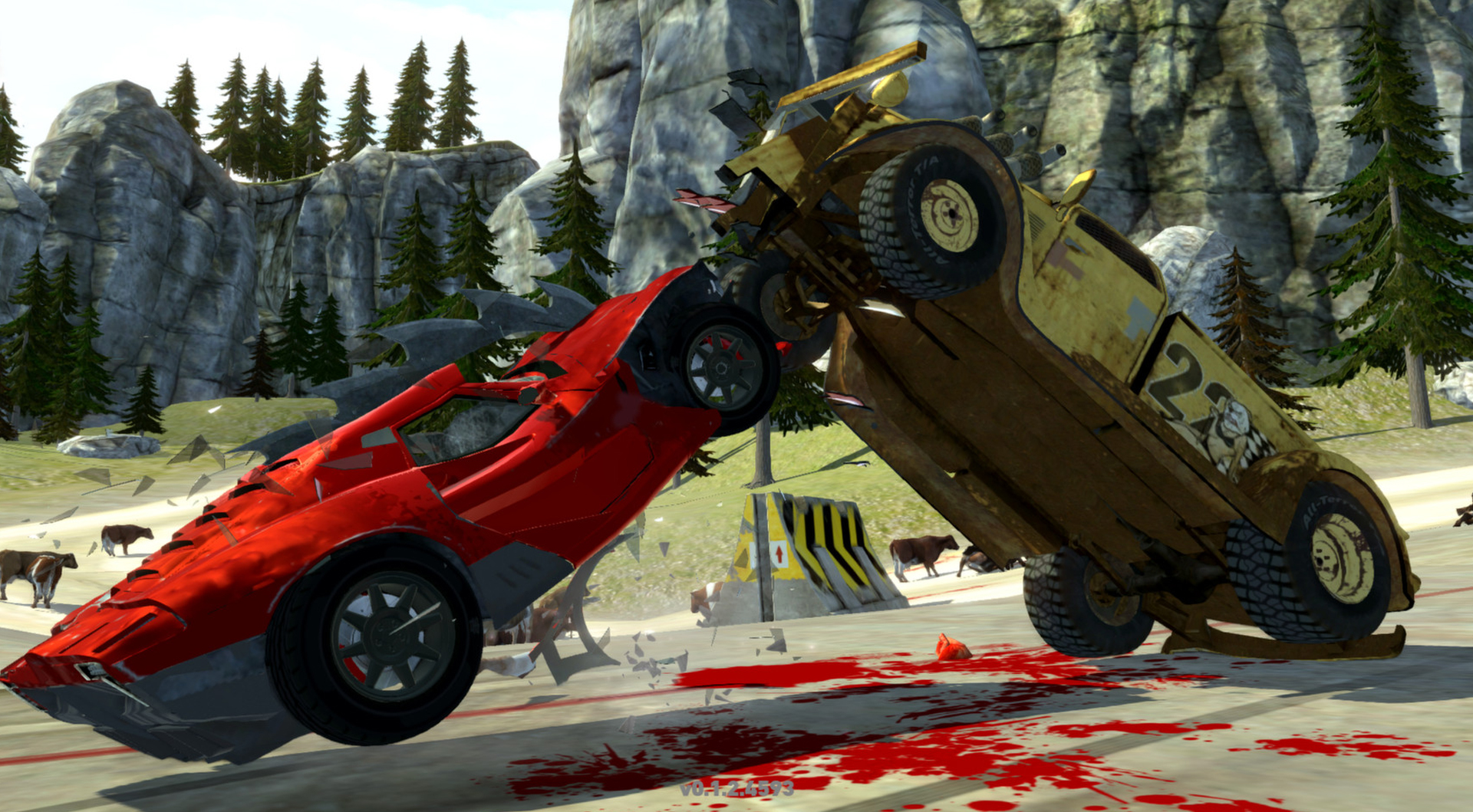
The final version of Carmageddon Reincarnation was released last year, two years later than originally intended – and yet the game was still plagued with performance issues. “With pressure on to get the project finished, the final release of Carmageddon: Reincarnation was far from where we wanted it to be technically, and the reviews and fan reaction just confirmed this,” says Barnden. “In today’s gaming landscape, where 60fps is the expected minimum, we sadly languished in the sub-30fps Failzone.”
Carmageddon Max Damage is therefore a chance for Stainless to learn from their experience gained from Reincarnation’s troubled development to finally realise their vision (PC owners of Reincarnation will be able to download Max Damage for free) and bring the brand back to console gamers.
Indeed, Barnden is confident that Max Damage won’t be crippled with the same shortcomings as Reincarnation. “Fortunately, we had secured funding for the console versions of the game. The extra time this gave the team, and the extra focus it demanded to improve the performance of the game, meant that everyone was able to concentrate on drilling into those technical shortcomings that harmed Carmageddon: Reincarnation,” he assures. “At the same time, more content was added, and the existing content was refined and visually improved. The degree to which the game expanded and improved in this period meant we felt justified in giving it its new title Max Damage to make a clear distinction between this version and the previous one.”
While Max Damage has been modernised for new audiences, long-time fans will find plenty of throwbacks to the original Carmageddon games – particularly with the eclectic vehicle selection, which combines old favourites with new killer cars.
“The vehicles added to Max Damage generally showcase the features of the game that came late on in production, and therefore inform the designs,” says Barnden. “For instance, we have another tracked vehicle, Project X (originally in Carmageddon). We have vehicles with very prominent spike weapons, Hevy Impaler (an old design) and the KVN Toucan (a new design), both of which allow the player to impale pedestrians and carry them around on the spikes – you can even impale multiple peds on one spike for a ‘Kebabed Bonus!’ There are some very large vehicles, a Big Rig (old, Splat Pack) and the Super Suppressor (new), both of which are rewards for reaching the latter stages of the expanded Career Mode.”
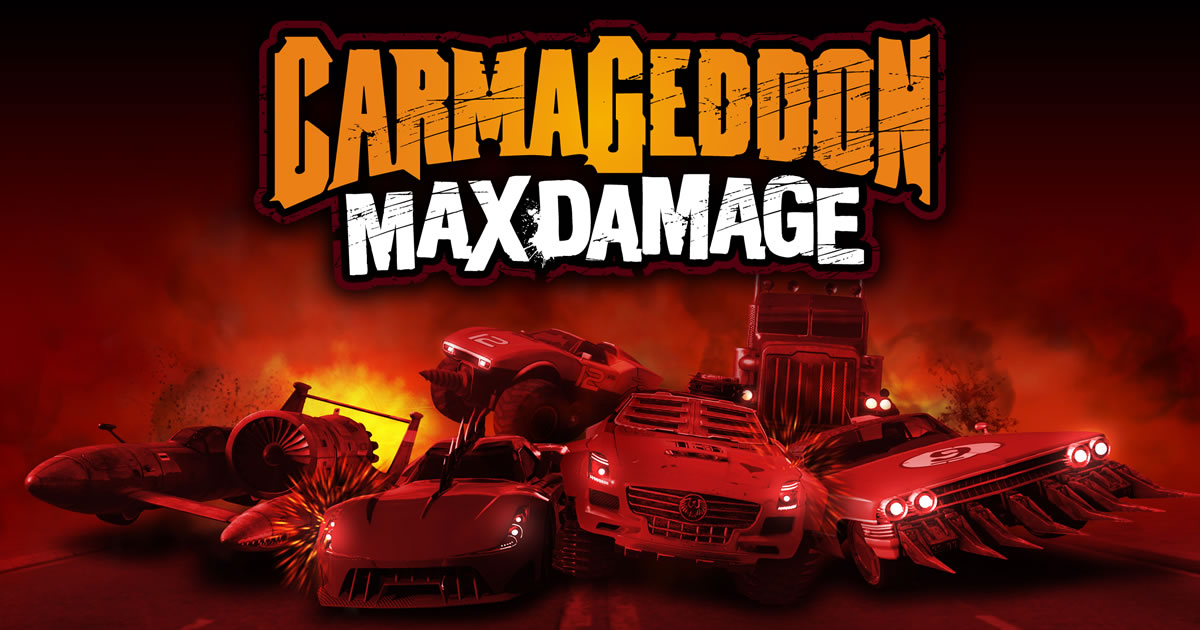
The game modes featured in Max Damage will also be familiar to fans, but there are also plenty of additional game modes to attract new players. “The original game was played in one of three ways, and every event in the game was based on the same rules: Wreck all the opponents, complete all the laps, or kill all the pedestrians,” Barnden explains.
“In the new game, there are now six different Event types:
- ‘Classic Carma’ which gives players three ways to win, as described above.
- ‘Death Race’ where players win conventionally, or destroy opponents and steal their laps!
- ‘Car Crusher’ featuring classic Death Match action, players respawn and it’s first to the target wreck count.
- ‘Ped Chase’ where players hunt down spawning tagged pedestrians in order to be the first to a target score.
- ‘Checkpoint Stampede’ has players chasing randomly spawning checkpoints, or wrecking opponents to steal their points!
- ‘Fox ‘n’ Hounds’ sees a player as the fox evading the chasing opponents – the hounds.
Of course, it wouldn’t be a Carmageddon game without some puerile PowerUps. Max Damage certainly hasn’t slacked in this area – there are no less than 90 different PowerUps available to dish out damage to your opponents and hapless pedestrians.
“My personal favourite PowerUps are the ones that do lots of damage to opponents and pedestrians alike!” says Barnden. “The Earthquake Bomb causes a massive seismic event around you that can wreck nearby cars and toss pedestrians skywards. The Slaughter Mortar comes as a pack of three, which is normally enough to take down a car or a settle a rowdy crowd down. And the Repusificators (which come in Ped and Opponent flavours) are everyone’s favourite, launching their target off into the distance on the end of a giant spring!”
With so many PowerUps available comes the risk that the gameplay will be unbalanced. This won’t be the case in Max Damage according to Barnden: “PowerUps are gameplay balanced by changing slightly between Single Player and Multiplayer”, he explains. “In Single Player it’s satisfying to be able to find some favourite PowerUps in familiar places in the levels, so we have some specific PowerUp positions that are consistent. But testing showed that it was too easy to farm PowerUps and make the game too easy, so we introduced a limit on how many of a PowerUp type a player can carry.”
“In Multiplayer, we had a lot of community feedback from the fans telling us about particular exploits and spamming that was happening due to experienced players farming or camping PowerUps. To fix this we substitute the specific PowerUps for random barrels, so the barrels all contain a random mix of PowerUps (albeit still in the offensive category if they’re red barrels, etc.). This plus the limit on the maximum of a PowerUp type that can be carried has fixed the problems.
“Players can also set up custom events with changes to all sorts of game parameters, including no PowerUps at all, or no PowerUp respawns. The result is that the community get to come up with their own crazy set of event types, such as the popular ‘Annihilator Jousting’ – a Car Crusher event with no PUps and everyone driving the game’s most impractical car, the top fuel dragster, Annihilator… And it’s ridiculously good, violent fun!
The controversy surrounding Carmageddon's violent gameplay meant that many of its revolutionary design elements were underlooked. The dynamic damage, for example, was particularly impressive for its time: “The original game featured real-time deformation of the vehicle meshes, which was revolutionary in its day,” says Barnden. “In Carmageddon 2 we showcased cars and peds that could be “deconstructed” on impact, with body parts flying off. And cars could also be split entirely in two! So taking this to the next level in Max Damage was essential.”
https://youtube.com/watch?v=jpuu5bMFgO4%3Frel%3D0
Indeed, current-gen hardware has allowed Stainless to significantly improve the damage modelling in Max Damage. “All the cars in Carmageddon: Max Damage can be damaged and destroyed using the game’s highly sophisticated dynamic damage system. All the bodywork and mechanical parts buckle, bend, hang or tear off. Tyres puncture, come off the rims, axles bend, wheels get torn off… the whole car can be bent or twisted in any axis. It can be split in two, across any plane! And then, at the press of a button, all that damage can be reversed and the car will repair itself as you drive and all parts will fly back to the car from wherever they fell – and get you bonus points if they happen to brain a pedestrian on their way back!” Action replays, which were also something of a novelty in the original, also return in Max Damage allowing you to marvel at the destruction from any angle.
Whereas the majority of racing games took place on linear tracks, Carmageddon ripped up the racing game rule book and introduced expansive maps filled with shortcuts and alternate routes that allowed you to freely explore. Open world tracks return in Max Damage: “The tracks in Max Damage vary greatly in scale and layout,” says Barnden. “The largest environments match the scale of the levels in the original game, meaning it takes several minutes of flat-out driving to get right around a level perimeter, and as well as that there’s a mass of inland roads, alleys, tunnels, and trails connecting it all together. As well as this we have smaller scale ‘arena’ tracks which still allow for a degree of roaming due to their 3D design, with layers of track area."
Carmageddon may have introduced several new gameplay mechanics to the racing game genre, but many of its then revolutionary features are now standard in modern racing games. The market has changed over the last 20 years so it doesn't have the same shock value either – you have to wonder, then, if Carmageddon is still relevant in today’s market.
“Carmageddon is still relevant because ‘there’s nothing quite like it,’" Barnden asserts. “It remains a unique driving game experience, due to its combination of extreme vehicle and PowerUp variety, surreal and rather British sense of humour, and the mixture of ways the player can achieve their goal. The market may have changed, but the basic principles of having fun will always remain!"
“Most of all Carmageddon is about tearing around at top speed, having a laugh and causing complete chaos, whilst in pursuit of objectives that deliver proper gameplay satisfaction!”
Like what we do? Support TeamVVV on Patreon: www.patreon.com/teamvvv



